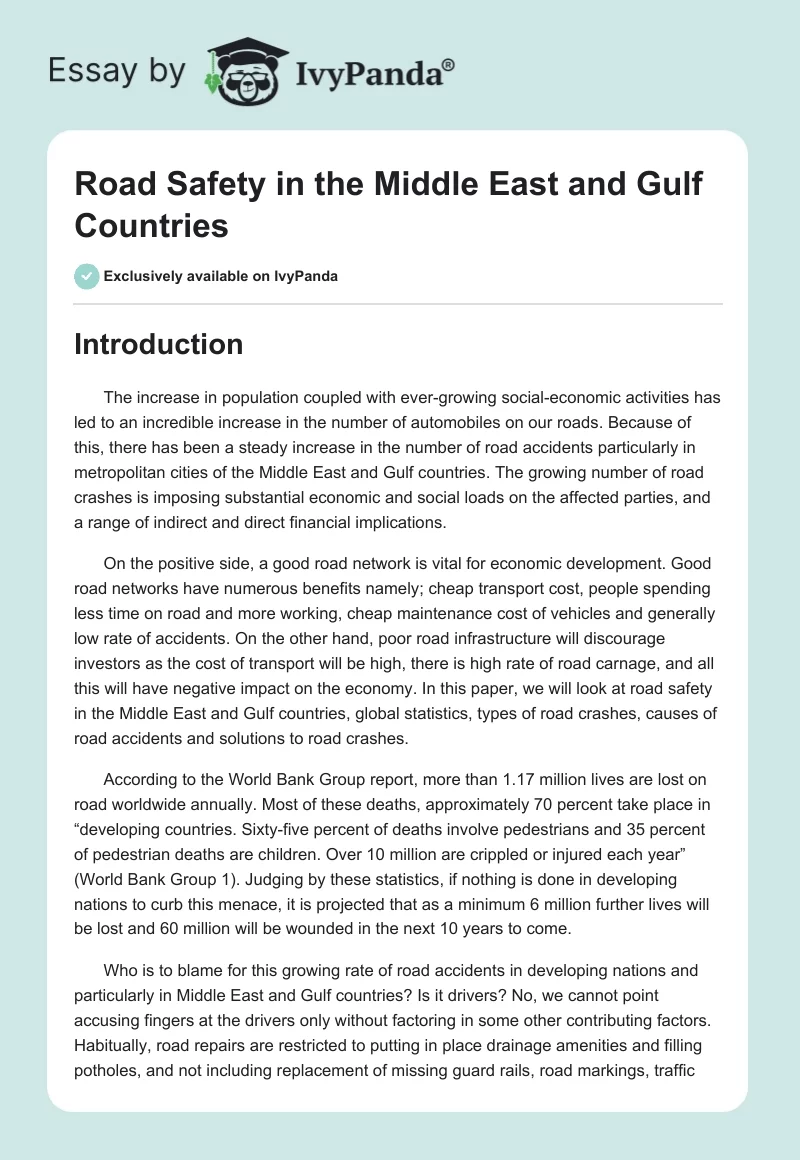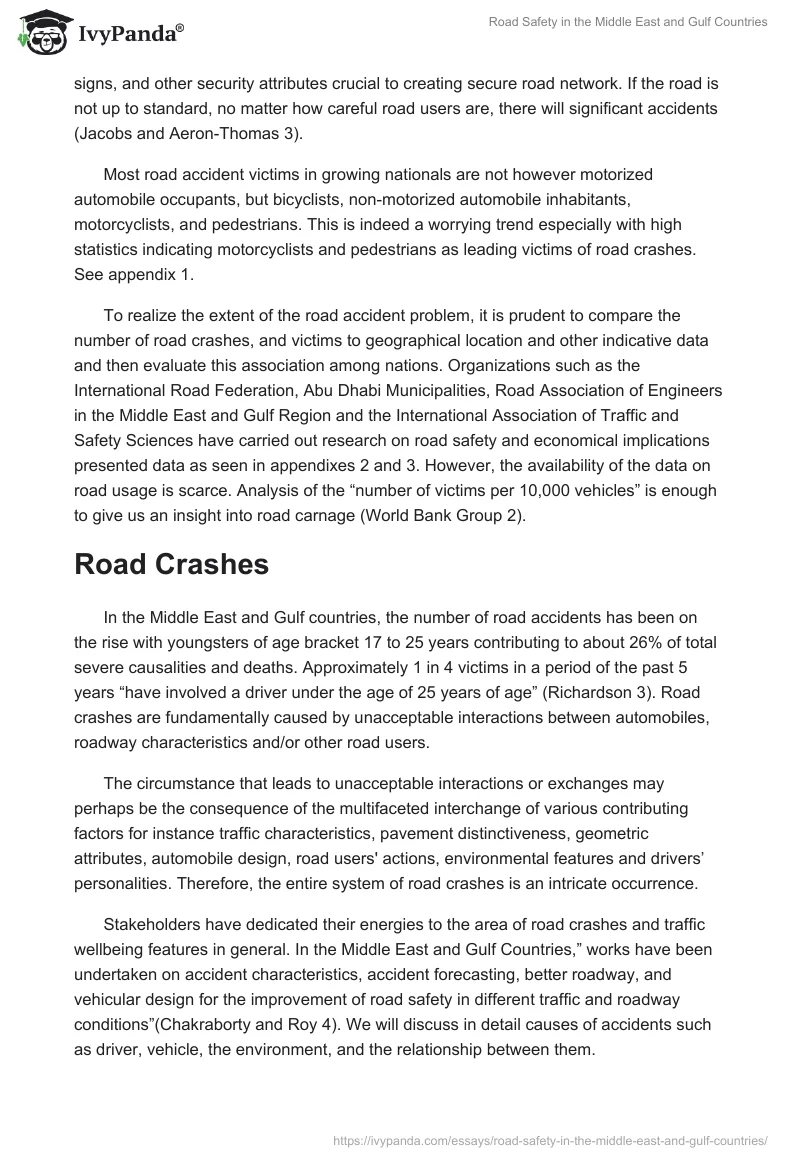Introduction
The increase in population coupled with ever-growing social-economic activities has led to an incredible increase in the number of automobiles on our roads. Because of this, there has been a steady increase in the number of road accidents particularly in metropolitan cities of the Middle East and Gulf countries. The growing number of road crashes is imposing substantial economic and social loads on the affected parties, and a range of indirect and direct financial implications.
On the positive side, a good road network is vital for economic development. Good road networks have numerous benefits namely; cheap transport cost, people spending less time on road and more working, cheap maintenance cost of vehicles and generally low rate of accidents. On the other hand, poor road infrastructure will discourage investors as the cost of transport will be high, there is high rate of road carnage, and all this will have negative impact on the economy. In this paper, we will look at road safety in the Middle East and Gulf countries, global statistics, types of road crashes, causes of road accidents and solutions to road crashes.
According to the World Bank Group report, more than 1.17 million lives are lost on road worldwide annually. Most of these deaths, approximately 70 percent take place in “developing countries. Sixty-five percent of deaths involve pedestrians and 35 percent of pedestrian deaths are children. Over 10 million are crippled or injured each year” (World Bank Group 1). Judging by these statistics, if nothing is done in developing nations to curb this menace, it is projected that as a minimum 6 million further lives will be lost and 60 million will be wounded in the next 10 years to come.
Who is to blame for this growing rate of road accidents in developing nations and particularly in Middle East and Gulf countries? Is it drivers? No, we cannot point accusing fingers at the drivers only without factoring in some other contributing factors. Habitually, road repairs are restricted to putting in place drainage amenities and filling potholes, and not including replacement of missing guard rails, road markings, traffic signs, and other security attributes crucial to creating secure road network. If the road is not up to standard, no matter how careful road users are, there will significant accidents (Jacobs and Aeron-Thomas 3).
Most road accident victims in growing nationals are not however motorized automobile occupants, but bicyclists, non-motorized automobile inhabitants, motorcyclists, and pedestrians. This is indeed a worrying trend especially with high statistics indicating motorcyclists and pedestrians as leading victims of road crashes. See Figure 1.
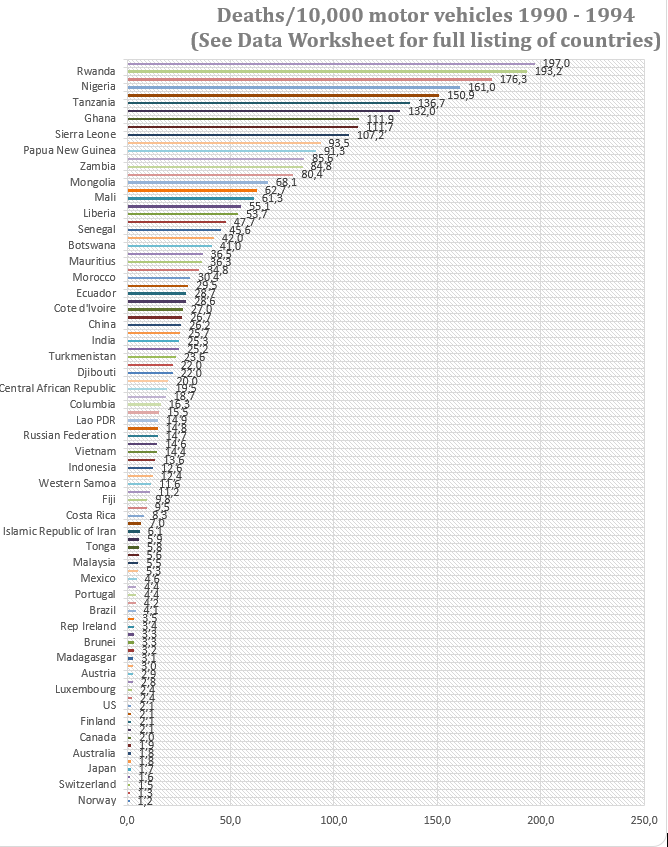
To realize the extent of the road accident problem, it is prudent to compare the number of road crashes, and victims to geographical location and other indicative data and then evaluate this association among nations. Organizations such as the International Road Federation, Abu Dhabi Municipalities, Road Association of Engineers in the Middle East and Gulf Region and the International Association of Traffic and Safety Sciences have carried out research on road safety and economical implications presented data as seen in Tables 2 and 3. However, the availability of the data on road usage is scarce. Analysis of the “number of victims per 10,000 vehicles” is enough to give us an insight into road carnage (World Bank Group 2).
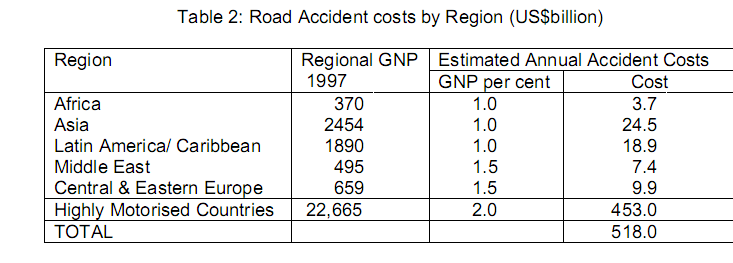
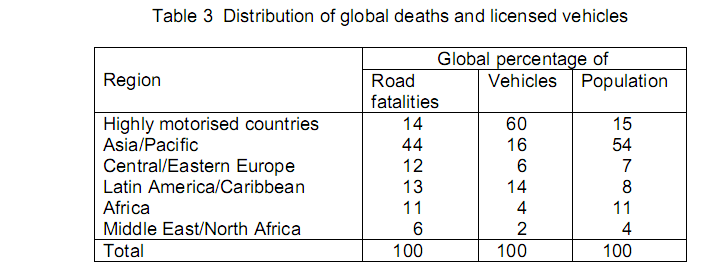
Road Crashes
In the Middle East and Gulf countries, the number of road accidents has been on the rise with youngsters of age bracket 17 to 25 years contributing to about 26% of total severe causalities and deaths. Approximately 1 in 4 victims in a period of the past 5 years “have involved a driver under the age of 25 years of age” (Richardson 3). Road crashes are fundamentally caused by unacceptable interactions between automobiles, roadway characteristics and/or other road users.
The circumstance that leads to unacceptable interactions or exchanges may perhaps be the consequence of the multifaceted interchange of various contributing factors for instance traffic characteristics, pavement distinctiveness, geometric attributes, automobile design, road users’ actions, environmental features and drivers’ personalities. Therefore, the entire system of road crashes is an intricate occurrence.
Stakeholders have dedicated their energies to the area of road crashes and traffic wellbeing features in general. In the Middle East and Gulf Countries,” works have been undertaken on accident characteristics, accident forecasting, better roadway, and vehicular design for the improvement of road safety in different traffic and roadway conditions”(Chakraborty and Roy 4). We will discuss in detail causes of accidents such as driver, vehicle, the environment, and the relationship between them.
Human Factors (Road Users)
Human beings tend to blame something or someone else whenever an accident occurs. Studies done in different parties of the world have concluded that approximately 80 percent of drivers caught up in automobile crashes alleged that the other driver possibly would have done something to avoid the crash. Many contributing factors may lead to driver-causing crashes. For instance, a driver will lose focus probably by an incoming call on their cell phones. While talking on the cell phone when driving, chances are high that the driver will ram in another vehicle, hit a pedestrian, or sway away from road and hit a tree as a result of divided attention. In rare cases do we witness crashes as a result of “‘Act of God,’ like a tree falling on a vehicle” (Smart Motorists 2).
All over the media, we see campaigns against overspeeding motorists, which is a leading cause of crashes. According to Smart Motorist,” the force experienced by the human body in a collision increase exponentially with speed” (4). Drivers especially youngsters and those driving public service vehicles, speed intentionally whereas they know the potential danger involved in doing this. The risks are further increased when roads are not well marked by traffic signs. Additionally, when a driver is speeding, he/she will easily knock a crossing pedestrian as opposed to those driving at an average speed.
As asserted by Smart Motorist, current automobiles are engineered to very secure benchmarks, and the surroundings they are “driven in is engineered to minimize the injuries suffered during an accident” (Smart Motorist 5). However, the most daunting task is to transform belligerent driver deeds and self-centered mindsets.
Additionally, aggressive behaviors such as drivers’ failure to observe road signs and signals, dangerous or numerous lane changes impaired driving, following closely another vehicle, and refusing to give the right of way to another motorist. However, it should also be noted that some accidents are maybe beyond control of some drivers. Take an example where a speeding or careless driver will unfortunately hit a driver driving carefully and thereby causing unnecessary death and destruction of property.
Equipment Failure
Car manufacturers are obligated to engineer automobiles that meet certain minimum-security benchmarks and this has been largely achieved. Unfortunately, cases of a tire bursting and/or tread division, brake failure, and steering/suspension malfunction have been reported to cause accidents. However, combined sum for the entire accident cases reported, automobile malfunction takes only less than 5 percent (International Federation of Red Cross 3).
Basically, when a vehicle is in motion especially when at high speed, should brake develop a malfunction, the driver will no longer have control of the vehicle and consequently, the automobile will either hit any vehicle ahead of it, may roll, or collide with any vehicle coming from the opposite direction.
With technological advances, radial tires are considered secure as compared to older types. However, “under inflation, the most frequent cause of tire failure is considered the main culprit in the recent Firestone tire-failure fatalities. Uneven or worn-out tires are the next most serious problem and can also lead to tire failure” (Richardson 5). Irregular or exhausted tires have been cited as another leading cause of automobile failure. If the tire is worn out, there will be not enough friction between the road and the tire and therefore breaking will be very difficult no matter how perfect the road is engineered. Jagged wear comes about by inappropriately tire equilibrium, out of order or skewed suspension (Agustin 3).
Car suspensions help keep tires in touch with the road predictably and steadily. Even a competent driver is helpless in cases where suspension or navigation system experiences a malfunction. Such malfunctions are disastrous, in particular at high speeds and on a potholed road.
Road Designs
In some cases, motorists have blamed road designs for road crashes. Authorities in the Middle East and Gulf countries have spent time and millions of money filling potholes, putting road barriers, guardrails, and railroad crossings to enhance road safety. Civil engineers and government provide custom-made designs to meet specific local conditions with special attention focusing on; traffic management tools whereby speed limit symbols, pedestrian crossing, traffic lights, roundabouts and turning lane, speed bumps, road identification symbols, behavioral management gadgets among others (Agustin 4).
Stormy environment can worsen existing vulnerability and occasionally produce fresh road surfaces such as snow and ice. When it rains, the road becomes slippery and when this is coupled with poor road banking, it makes the situation even worse.
Poor Road Maintenance
Roadway maintenance timetables and course of actions differ significantly from country to country and city to city, so countrywide benchmarks do not actually exist. Some impending roadway upholding deficiencies that may lead to road crashes include:
- Dull road symbols, and symbols covered by plants
- fragments on the road
- The roadway is under construction but is poorly marked to give enough warning to motorists. But sometimes this has been blamed on drivers who ignore those symbols and continue to drive at high speeds
Types of Road Crashes
Road crashes occur in different ways and the way it occurs is related to the degree of damage that will occur. Some of the types of road crashes include red-light runner crash, rear-end crash and head-on collision each with varying severity depending on speed that we vehicles were traveling at.
Red Light Runner Crash
This is whereby one driver fails to observe red lights near intersections and/or roundabouts and drives on when he/she is supposed to stop while the other observing green light drives on and therefore crashes somewhere in the middle of an intersection or roundabout. Sometimes red-light running crashes are never intentional for example if in road junctions where there is a horizontal road curve or the crossroad has a downgrade or upgrade distance the halting view may be constrained by possible sight hindrances around the junction.
If those driving are not in a position to notice signal altering and probable contradictory automobile, they have a bigger probability of running a red light and colliding. It has emerged that traffic dynamics such as “number of lanes, crash time, weather, highway character, day of week, urban or rural location, speed limit, driver age, alcohol or drug use, physical defect, and vehicle type were significantly associated with the risk of red-light running crashes”(Yan, Radwan and Birriel 1).
The severity of the accident depends on factors us as the speed of the collision, the angle of collision, and the types of collision. If the vehicles involved in a crash were in high momentum, then the chances are high that the crash may lead to instant loss of life and complete damage of the vehicles. On the other hand, if speeds were low, there might be minor injuries with less destruction of vehicles involved. Take for instance; if a big truck, in this scenario, hit a small car there are high chances of serious injuries if not death and a high degree of property destruction.
Rear-end Collision
This is road crash whereby a vehicle crashes into or hits the motor vehicle in front or ahead of it, normally as a resulting following the other vehicle closely(tailgating), brake failure, or panic stops. Typical cases occur when suddenly the first car slows down probably to give a pedestrian time to cross while the second vehicle does not have adequate space to brake and thereby hitting it from behind.
In most cases, the severity of such crashes is small (whiplash) but in severe instances, lasting damages such as herniation possibly will arise and generally, those in the first class are the highly affected. In terms of vehicle damage, it depends on the speed at which the second vehicle was moving at with high speeds causing more damage. Additionally, if one car is huge than the other, then the smaller car will be damaged to a higher degree.
Head-on Collision Crash
Statistically, this kind of collision has the worst outcomes due to the speed of vehicles involved in collision. In most cases, lives are lost or permanent damages prevail in such crashes. This kind of crash occurs when one motor vehicle unintentionally drifts into the lane of an approaching vehicle. Nevertheless, the core reason occasionally “lies in a navigation overcorrection after veering to the side of the road as opposed to the center” (Sabnal 2). In some cases, there has been steering wheel failure or swaying of vehicle particular when it rains due to decrease in friction force and risks are multiplied if the was moving at thrilling speed.
Secondly, a head-on collision is caused by a miscalculation by drivers when overtaking. As the driver tries to overtake, they invade into oncoming car’s lane and thereby causing a head-on collision.
Solution of Crashes
Appreciating that over 80 percent of road crashes are caused by pure human error is a major step towards preventing further loss of lives. First, drivers should be encouraged to observe speed limits and never to go below or further than recommended speed restrictions so that risks of being hit or hitting another vehicle are reduced. If a driver over speeds, he/she faces a higher probability of losing grip on the vehicle and will either collide with an oncoming vehicle or roll. To stop these, stiffer penalties must be introduced in the Middle East and Gulf Countries to those found flouting traffic rules with a possibility of revoking their driving licenses.
Secondly, road safety education should be done in these nations. Pedestrians also contribute significantly to road accidents and consequently all stakeholders must take the initiative of educating them. On the other hand, drivers are encouraged to be trained by qualified institutions only, to be equipped with necessary skills. It has been noted with deep concern that, motorbike is nowadays the leading cause of accidents and this is attributed to training. Most of them never attend formal training. Law enforcers must ensure that those without valid driving licenses are banned and even if they have valid licenses but flout rules, they should be taken for refresher courses.
Driving under influence of alcohol and/drug must be stopped at all costs as this reduces the driver’s driving skills and concentration by 95 percent. Citizens are encouraged to take with them friends who will drive them once they are drunk or use public vehicles. Since traffic police have adequate machinery to deal with this, they should be more vigilant and deal with those found driving risking their lives and the lives of other road users (Jacobs and Aeron-Thomas 13).
We cannot rule out poor road conditions, faded/unclear road symbols, and unmarked roads under construction as contributing factors to road crashes in Gulf and Middle East countries. Government authorities charged with road maintenance responsibilities must ensure that all potholes are filled; road bumps are clearly marked and erected where they are supposed to be. Where we have road intersections, traffic lights must be installed at an angle clear to all motorists to prevent run red crashes.
Finally, road and car engineers must deliver standard roads and vehicles respectively. Some cases of equipment failure have been reported and the government must deal with this. Governments must step efforts to ensure only those vehicles meeting minimum standards are allowed on the road. Additionally, regular checks must be done on those vehicles already registered to weed out faulty ones. When awarding tender for road construction, all those companies must be properly evaluated to ensure that qualified contractors who will deliver quality work are the only ones awarded.
Conclusion
Generally, road crashes are high in Gulf, Middle East and third world countries as compared to occurrence in developed countries. Road crashes are mainly caused by human factors, equipment failure, poor road conditions, and substandard road design. Of the listed factors, the human factor takes about 75 percent of the causes of road accidents.
The degree of severity of an accident varies depending on contributing factors as speed of collision, type of crash and type of vehicles involved. A head-on collision is the worst as compared to run red or rear-end road crash. Middle East and Gulf countries governments have stepped up efforts to curb road carnage by increasing stiffer regulations, educating its citizens, upgrading road networks among other preventing measures.
Works Cited
Agustin, Ivonne. “Knowing the causes and solutions to road accidents.” Middle East Road Safety Journal, 7.1 (2009).
International Federation of Red Cross. Road safety. New York: Prentice Hall, 2010.
Jacobs, Dan and Aeron-Thomas, Amy. “A review of global road accident fatalities.” Road Safety Management Journal, 10.5(2009): 1-15.
Richardson, Peter. “Road safety crash statistics.” Lothian & Borders Police Road Safety Unit Journal, 7.2 (2004):1-19.
Sabnal, Junice. “Road accident: head-on collision.”Road accidents in Gulf Countries Journal, 34.7 (2007):1-19.
Smart Motorist. Red light running crashes are on the increase. Washington: Natl. Acad., 2009.
World Bank Group. What causes accidents? New York: United Nations, 2008. Print.
Yan, Xuedong V., Radwan, Essam, and Birriel, Elizabeth.” Analysis of red light running crashes based on quasi-induced exposure and multiple logistic regression method.” Transport Research Record Journal, 1908.3 (2005):1-10.

